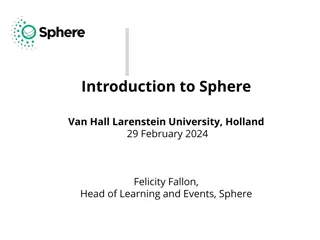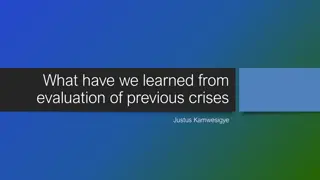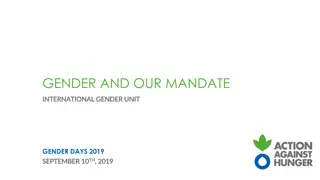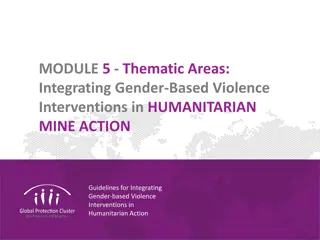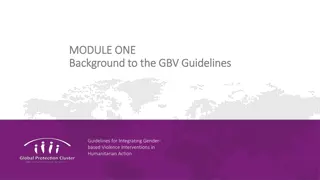Understanding Gender-Based Violence in Humanitarian Action
Explore core concepts such as sex, gender, human rights, and power in the context of gender-based violence (GBV) interventions during humanitarian efforts. Learn about the differences between sex and gender, the violation of human rights through GBV, and the various types of power dynamics contributing to such violence.
Download Presentation

Please find below an Image/Link to download the presentation.
The content on the website is provided AS IS for your information and personal use only. It may not be sold, licensed, or shared on other websites without obtaining consent from the author. Download presentation by click this link. If you encounter any issues during the download, it is possible that the publisher has removed the file from their server.
E N D
Presentation Transcript
MODULE MODULE T TWO: Defining Gender Defining Gender- -based Violence WO: based Violence (GBV) (GBV) Guidelines for Integrating Gender- based Violence Interventions in Humanitarian Action
Core Concepts in understanding GBV: Sex and gender Human rights Power Violence Harm Consent Guidelines for Integrating Gender-based Violence Interventions in Humanitarian Action
Activity: what is gender? Divide into two groups Draw or write down the personality traits, attributes and roles that are associated with: Group 1: women Group 2: men Guidelines for Integrating Gender-based Violence Interventions in Humanitarian Action
Core concept 1: GENDER GENDER What is the difference between sex and gender? Why is this important when talking about gender-based violence? Guidelines for Integrating Gender-based Violence Interventions in Humanitarian Action
Core concept 2: HUMAN RIGHTS HUMAN RIGHTS Key HR instruments: The Universal Declaration of Human Rights (UDHR, 1948) The Convention on the Elimination of all forms of Discrimination Against Women (CEDAW, 1979) The Convention on the Rights of the Child (CRC, 1989) Guidelines for Integrating Gender-based Violence Interventions in Humanitarian Action
GBV violates the rights to: Life, liberty and security of the person The highest standard of physical and mental health Freedom from torture or cruel, inhuman, or degrading treatment or punishment Freedom of opinion and expression, to education, to social security and to personal development Guidelines for Integrating Gender-based Violence Interventions in Humanitarian Action
Core concept 3: POWER POWER Power can be both real or perceived. What are some different types of power? Gender-based Age-based Class-based Ethnicity Religion Physical Economic Political Social Educational Guidelines for Integrating Gender-based Violence Interventions in Humanitarian Action
What is power? Power is the ability to control and access resources, opportunities, privileges and decision-making processes. Guidelines for Integrating Gender-based Violence Interventions in Humanitarian Action
Core concept 4: VIOLENCE VIOLENCE What are some forms of violence? o Physical, sexual, emotional, psychological, social, economic, denial of resources or opportunities Importance of the concept of harm How can different forms of violence be gendered? Guidelines for Integrating Gender-based Violence Interventions in Humanitarian Action
Core concept 5: CONSENT CONSENT Consent means saying yes, agreeing to something. Informed consent means making an informed choice freely and voluntarily by persons in an equal power relationship. Acts of GBV occur without informed consent Saying yes is not true consent if said under duress Children under age 18 are unable to give informed consent for acts such as female genital cutting (FGC), marriage, sexual relations, etc. Guidelines for Integrating Gender-based Violence Interventions in Humanitarian Action
GBV = rape, right? Yes, but also: Domestic violence/IPV Harmful traditional practices Forced/early/child marriage Denial of resources or opportunities Sexual harassment Sexual exploitation Sex-selective abortion Trafficking etc . Guidelines for Integrating Gender-based Violence Interventions in Humanitarian Action
Definition of GBV GBV is an umbrella term for any harmful act that is perpetrated against a person s will and is based on socially ascribed (i.e. gender) differences between males and females. It includes acts that inflict physical, sexual or mental harm or suffering, threats of such actions, coercion and other deprivations of liberty. Guidelines for Integrating Gender-based Violence Interventions in Humanitarian Action
Why does GBV exist? In small groups, identify: Root causes for GBV Specific risk factors for GBV in your context? - What increases the likelihood of GBV occurring? Consequences of different forms of GBV? - Physical, social, economic, psychological? Guidelines for Integrating Gender-based Violence Interventions in Humanitarian Action
Consequences of GBV Forms of GBV Contributing factors Root causes of GBV Guidelines for Integrating Gender-based Violence Interventions in Humanitarian Action
Root causes and contributing factors of GBV: Root Causes Contributing Factors / Risk Factors Behavioural: alcohol, drugs, boredom, retaliation Power Imbalance Structural: camp layout, access to services Gender Inequalities Systems: impunity, representation, participation Disregard for human rights Guidelines for Integrating Gender-based Violence Interventions in Humanitarian Action
Consequences of GBV: Physical health consequences Psychological health consequences Social & Economic consequences Physical injury HIV/AIDS STIs Depression Fear Self-blame Victim-blaming Stigmatisation Rejection Unwanted pregnancy Anxiety Isolation Unsafe abortion Mental illness Decreased earning capacity/contribution Fistula Suicidal thoughts/actions Increased poverty Death Risk of re-victimization Guidelines for Integrating Gender-based Violence Interventions in Humanitarian Action
Example of Democratic Republic of the Congo DRC Survivors: Socio-economic problems Challenges in social reintegration Problems with attachment to or rejection of the child Unsafe abortion Children of survivors: Delays in physical and emotional development Seen as time-bomb : children who will turn against their families Stigmatization, neglect/abuse or rejection Lack of access to food, health care or education Guidelines for Integrating Gender-based Violence Interventions in Humanitarian Action
GBV and VAWG UN Declaration on the Elimination of Violence Against Women (1993): Violence against women is a manifestation of historically unequal power relations between men and women, which have led to domination over and discrimination against women by men and to the prevention of the full advancement of women. Guidelines for Integrating Gender-based Violence Interventions in Humanitarian Action
Can GBV happen to men and boys? Gendered vulnerabilities can put ANYONE - men, women, boys and girls - at heightened risk for violence. Humanitarians must ensure care and support for all survivors. The contexts, causes, and consequences of violence against women and girls/men and boys are different. Risk analyses that take gender into account are critical to inform programming. take gender into account are critical to inform programming. Risk analyses that The Guidelines recognize the heightened vulnerability of women and girls and other specific populations to GBV and provide targeted guidance to address these vulnerabilities - including through strategies that promote gender equality. Guidelines for Integrating Gender-based Violence Interventions in Humanitarian Action
GBV, VAWG, VAMB What are some examples from your work of working specifically to address GBV against women and girls? What are some examples from your work of working specifically to address GBV against men and boys? Guidelines for Integrating Gender-based Violence Interventions in Humanitarian Action
GBV and VAWG, contd GBV is a cause and consequenceof women s inferior political, economic and social status Boys and men can be exposed to gendered violence, but women s inferior status virtually everywhere in the world means that they are its primary targets. Men typically hold more of the power in societies worldwide: physical, economic, legal and: have more access to and control of resources have more opportunities have more economic freedom including freedom to leave violence Guidelines for Integrating Gender-based Violence Interventions in Humanitarian Action
Children & GBV Being a boy or a girl makes a child vulnerable to particular forms of violence Violence is learned through socialization into social norms and expectations around masculinity and femininity, sex and sexuality, male entitlement Guidelines for Integrating Gender-based Violence Interventions in Humanitarian Action
Boys & Violence More likely to experience harsh physical punishment within the family and schools; peer-based violence perpetrated by other boys At greater risk of perpetrating violence than girls Guidelines for Integrating Gender-based Violence Interventions in Humanitarian Action
Girls & Violence At higher risk than boys for infanticide, sexual abuse, educational and nutritional neglect, forced prostitution and FGM At risk because they have the least power, status and control over their own bodies and over resources within the family and community Relative position of powerlessness in relation to adults, but also in relation to males, including male children Guidelines for Integrating Gender-based Violence Interventions in Humanitarian Action
GBV and LGBTI Violence against an LGBTI individual constitutes GBV when it is driven by a desire to punish those seen as defying gender norms (OHCHR, 2011). Homosexual men and transgender women can be at particular risk because of gender stereotypes LGBTI survivors also often have limited ability to access support Guidelines for Integrating Gender-based Violence Interventions in Humanitarian Action
Summary of GBV: Violence that is based on gender relations, roles, norms, expectations, limitations etc. Involves the abuse of power Includes some type of force, including threats and coercion, and results in harm Characterized by the lack of informed consent Violates a number of universal human rights protected by international instruments and conventions Guidelines for Integrating Gender-based Violence Interventions in Humanitarian Action
Questions? Questions? Guidelines for Integrating Gender- based Violence Interventions in Humanitarian Action




